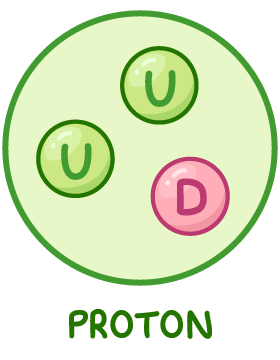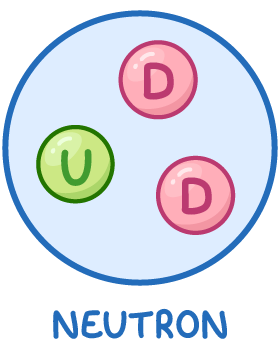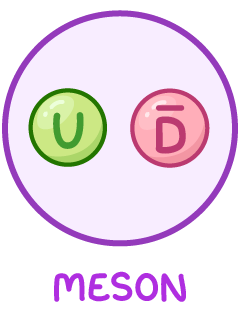Quarks
Quarks are the fundamental subatomic particles that make up all hadrons.
Types are:
- Up quarks
- Down quarks
- Strange quarks
They have fractional electric charges and baryon numbers:
| Quark | Charge | Baryon Number | Strangeness |
|---|---|---|---|
| up | + | + | 0 |
| down | - | + | 0 |
| strange | - | + | -1 |
Antiquarks
Antiquarks are the antiparticles to quarks with opposite baryon number and strangeness:
| Name | Charge | Baryon Number | Strangeness |
|---|---|---|---|
| anti-up | - | 0 | |
| anti-down | + | - | 0 |
| anti-strange | + | - | +1 |
Hadron quark compositions
The difference between Baryons and Mesons is the number of quarks that they contain. Baryons contain combinations of 3 quarks or 3 antiquarks.
Example: Proton
The proton contains 2 up quarks and 1 down quark.

| Property | Calculation |
|---|---|
| Charge | |
| Baryon number |
Example: Neutron
The neutron contains 1 up quark and 2 down quarks.

| Property | Calculation |
|---|---|
| Charge | |
| Baryon number |
Mesons:
Mesons contain one quark and one antiquark. They have a baryon number of 0.
Example: π+
The π+ meson is comprised of 1 up quark and 1 anti-down quark

| Property | Calculation |
|---|---|
| Charge | |
| Baryon number |
Discoveries in particle physics
Predicting existence of quarks and other particles relies on collaborative analysis from large teams (e.g. at CERN).
Confirming predictions cements acceptance of theories like quarks making up all hadrons.
So quarks form the basis for all composite particles feeling the strong interaction. Their properties explain how hadrons gain their mass, charge and stability.
Quarks & Antiquarks
This lesson covers:
- Quarks as fundamental particles combining to form hadrons
- The properties of quarks
- How antiquarks are the antiparticles to quarks
- Examples of quark compositions in protons, neutrons and mesons